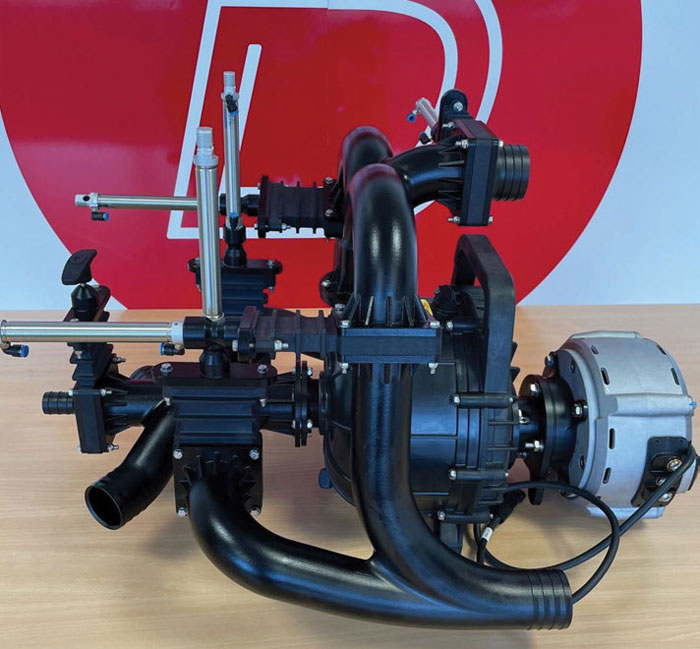

Faster tacks, smart logic, easy operation. Diverse Performance Systems has found some intriguing new ways to improve on the standard water ballast system
Fully crewed IRC yachts increasingly use water ballast to reduce weight of the keel bulb without sacrificing stability upwind and when power reaching. Despite the ubiquity of such systems in short-handed racing the top IRC teams have found scope for innovation and improvement. RORC Commodore James Neville’s new Carrington built Carkeek 45 Ino Noir, for example, has a water ballast system with 500 litre tanks each side developed by Hamble, UK-based Diverse Performance Systems. This is an evolution of the setup on Niklas Zennström’s Carkeek 52 Ran 8, which launched last year.
‘We’ve made it neater, lighter and more compact,’ says Diverse MD Nick McGarry. ‘We’ve also added our own pneumatic actuation systems with on-deck push button control.’ Instead of the stand-alone valves used by Imoca 60s, custom units with pneumatic valves iare ntegrated with the manifold. This reduces weight and complexity, streamlines installation and allows for a very simple actuation system on deck.
Other key elements include a pair of hull scoop valves that minimise aeration at speed and retract when not in use, plus a high capacity 24 or 48V electric pump rated to move up to a whopping 900 litres of water per minute. An extra-large crossover pipe transfers water from windward to leeward in only five to 10 seconds when tacking. ‘We worked hard to make tack speed as fast as possible,’ says McGarry, ‘so the system works flawlessly for inshore racing, when decisions often need to be made at the last minute.’
In a crash tack, the crossover valve automatically closes as the boat comes upright. Any water left on the undesirable side can then be pumped to windward in a few seconds using the electric pump. The system logic means there’s no chance of pumping against a closed valve, yet on deck the controls are impressively streamlined with a minimum of buttons: tack, fill to port/starboard and dump. Iindicator lights can show whether a tank is full or empty. A level gauge could be supplied, but might take a crew member’s attention away from more important matters.
‘If you’re going upwind and press “tack” the system already knows the water's up there,’ says McGarry. ‘It already knows which valves are open and what has to be done to dump the water over to the other side.’ The control system has sensors inside the tanks so it knows when the tank is empty or the other side is full and will therefore close the valves automatically. ‘Whoever's operating the valve system doesn't have to think much about it – even though there are seven or eight valves.’
A 900-litre per minute pump has potential to consume a lot of power, but it typically doesn’t run very often, especially given most transfers are done using gravity. Equally, the compressor for the pneumatic actuation system is only the size of a small car tyre pump. A pair of 1250Wh Lithium batteries therefore provide ample power to run the system for a day of racing. The key metric here is the number of manoeuvres, not the duration of the race, and offshore races may be less demanding on power than inshore competition.
While the basic principles of the system are straightforward, as always the level of attention to detail needed can be extremely time consuming. This aspect encompasses everything from ensuring all the water can be scavenged from the leeward tank and doesn’t remain in pipework – every gram matters – to the robust control system logic that means transferring ballast is a minimal distraction when crews are fully occupied in manoeuvres.
The systems are engineered to be as compact as possible so they can be dropped into a boat as a neat package rather than having a myriad of pipes and valves scattered around. The units need periodic maintenance like any system that pumps seawater ‘but we try to make that as easy as possible for the crews,’ says McGarry. ‘It’s simple to pull apart, clean and put back together.’
Diverse Performance Systems has a number of future water ballast projects in the pipeline, including the updated Mini-Maxi Bella Mente, which will have roughly twice the volume of ballast and therefore twin cross-over pipes that will allow equally quick tacks as much smaller boats when racing inshore.
Click here for more information on Diverse Performance »
We invite you to read on and find out for yourself why Seahorse is the most highly-rated source in the world for anyone who is serious about their racing.
To read on simply SIGN up NOW
Take advantage of our very best subscription offer or order a single copy of this issue of Seahorse.
Online at:
www.seahorse.co.uk/shop and use the code TECH20
Or for iPad simply download the Seahorse App at the iTunes store


